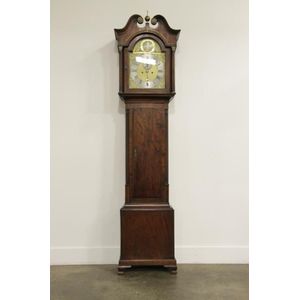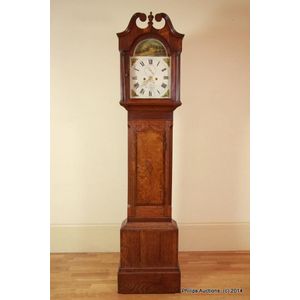Provincial Oak Longcase Clock by Walker & Hughes
You must be a subscriber, and be logged in to view price and dealer details.
Subscribe Now to view actual auction price for this item
When you subscribe, you have the option of setting the currency in which to display prices to $Au, $US, $NZ or Stg.
- Oak - Native to Europe and England, oak has been used for joinery, furniture and building since the beginning of the medieval civilisation. It is a pale yellow in colour when freshly cut and darkens with age to a mid brown colour.
Oak as a furniture timber was superceded by walnut in the 17th century, and in the 18th century by mahogany,
Semi-fossilised bog oak is black in colour, and is found in peat bogs where the trees have fallen and been preserved from decay by the bog. It is used for jewellery and small carved trinkets.
Pollard oak is taken from an oak that has been regularly pollarded, that is the upper branches have been removed at the top of the trunk, result that new branches would appear, and over time the top would become ball-like. . When harvested and sawn, the timber displays a continuous surface of knotty circles. The timber was scarce and expensive and was used in more expensive pieces of furniture in the Regency and Victorian periods. - Date Aperture - A date aperture is a cut out section in the face of a watch or clock, displaying the day of the month.
- Spandrel - An architectural term that in horology refers to the triangular ornamental decoration in the corners of of the dial plate. The spandrels are usually of cast brass and may be additonally chased and engraved. On painted dial clocks the spandrels are also usually painted.
This item has been included into following indexes:
Visually similar items

An early 19th century mahogany cased grandfather clock the brass dial with a silvered chapter ring signed Geo. Bruce London. Height 218 cm. Width 45 cm. Depth 22 cm

An English 18th century oak and mahogany cross banded eight day grandfather clock. Maker: Simpson of Lincoln. 210 cm high, 43 cm wide, 20 cm deep.

An English oak longcase clock. Maker: Sam Corbett Hadleigh. 2m high, 44 cm wide, 21.5 cm deep.

An English longcase clock, mahogany case with Georgian brass dial 'Mathew Wylie'. 207 cm high, 55 cm wide, 26 cm deep.
